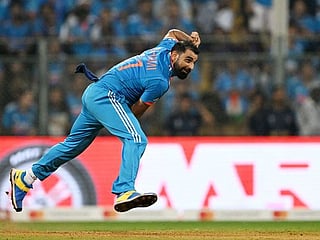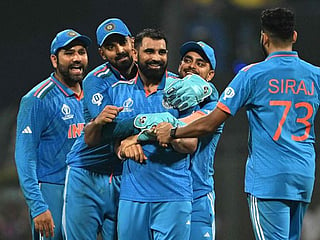How Australia denied a home triumph for India in Cricket World Cup
Travis Head’s century lifts Australia to their sixth title as India suffer first loss

Winning is a habit. Australia’s sixth World Cup win reaffirms the adage. Even the loss of the first two matches didn’t frazzle them. The Pat Cummins-led side gained in strength with eight straight wins to play their best cricket in the final and hand India the first defeat of the tournament.
Travis Head made the difference on Sunday when Australia chased 241 for a win on a slow pitch at the Narendra Modi Stadium in Ahmedabad. His century lifted Australia to a six-wicket victory with plenty to spare, and India were left to lick the wounds.
On a difficult pitch, the lefthander curbed his strokeplay when Australia lost three early wickets before stringing together a 192-run partnership with Marnus Labuschagne that took them to the cusp of victory. When Head was caught by Shubman Gill off the bowling of Mohammad Siraj, the South Australian had struck 137 from 120 balls.
What went wrong for India?
Head paced his innings well, negotiating the swing and movement of India’s opening bowlers Jasprit Bumrah and Mohammad Shami. Once Labuschagne, who has had a quiet tournament, found his bearings, Head took the Indian attack by the scruff of the neck. Pace or spin, it didn’t matter for Head. He was in total control. And the result was never in doubt.
Where did India go wrong? Did India bat too slowly to give the upper hand to the Australian bowlers? Was India timid in defending the total? In retrospect, it’s easy to find flaws. And there were several missteps.
India were unlucky to lose the toss. Batting first wasn't easy and the pitch eased after the powerplay when Australia chased. But you can't blame the toss. Teams have to put forth the best show irrespective of the toss. India’s travails began with the batting.
Expectedly, captain Rohit Sharma took the fight to the bowlers, peeling off 47 runs from 31 balls, but did he have to lash out in search of another six when he had already struck a six and a four off Glenn Maxwell off successive balls? Maybe not. That was more T20 style. But that’s how Rohit had played in the tournament, and it helped India score big totals and chase down targets effortlessly.
Be that as it may. It indeed was a big moment in the game. Maybe even the turning point. And it took a magnificent catch to end the rousing knock. Head’s hands were there to take the leaping catch after running from extra-cover with the ball dropping over his shoulder. More like Kapil Dev’s catch to dismiss Vivian Richards in the 1983 final.
After Rohit’s departure, boundaries just dried up, and Australian bowlers clawed back into the match. Josh Hazlewood, who leaked 25 runs in three overs when Rohit was on the rampage, returned to find reverse swing and landed several bodyblows on India; he finished with 2-60.
Hazlewood’s return to the attack was also prompted by the slow scoring of Virat Kohli (54 off 63 balls) and KL Rahul (66 off 108), who eschewed risks when India slumped to 83/3. When Kohli played a Cummins’ delivery on the stumps, India were 148, but his 67-run stand with Rahul came off 109 balls. That was a little too slow, although batting conditions were challenging. That allowed Cummins to bring Mitchell Marsh and Head to bowl as insurance if Hazlewood couldn’t return.
The fact that India went through 97 balls without a boundary speaks of the Australian bowlers’ dominance. With Indian innings in slumber, Hazlewood’s strikes opened the path for Mitchell Starc to return for a cleanup job. That was excellent captaincy from Cummins, who also turned in a fine spell (2-34) after opting to bowl first. Australian fielding too was top-notch as they kept cutting off boundaries, denying India at least 25 runs. That’s 25 less to chase.
Contrast the Indian innings with the Australian chase. Bumrah and Shami had reduced them to 47/3 when Head and Labuchagne embarked on the rebuilding job. While Labuchagne dropped anchor, Head never missed opportunities to clatter the boundaries. He even swung Kuldeep Yadav over midwicket so that the left-arm leggie does not become the threat he was in the previous games.
Unlike in India’s rebuilding phase, Australian batters never allowed the bowlers to dictate the terms. That was where the game was won and lost. You could argue that the pitch had eased out, but when a team have lost three wickets in the first seven overs of the chase, they are under the pump. It’s time to turn up the heat. India didn’t. India couldn’t.
Did India lack aggression?
Did Rohit miss a trick there? Could his captaincy been more aggressive? After all, 240 is not much of a total to defend. You have to bowl out the opposition to win such games. India did that against England in a similar situation. But that was a league game, and this is the final. There’s far too much at stake.
Yet, Rohit should have attacked with a slip. Remember how India kept Sunil Gavaskar at first slip while defending 183 against the mighty West Indies in the 1983 final? But that was at Lord’s, and the ball swings a lot in England. True, there wasn’t much turn at the Motera stadium. If Rohit had kept a first slip, two edges would have gone to hand, and maybe the match would have taken a different course. Well, that’s the benefit of hindsight.
A puzzling decision was to start with Shami, who had been coming first change. Shami did send back David Warner with his first ball of the final, but he didn’t look comfortable and sprayed the ball a bit. He seemed too keen to take wickets. and gave away some easy runs. Was it because Shami was bowling at an unfamiliar phase of the game? YOu could say he bowls with the new ball for Gujarat Titans in the Indian Premier League, but the World Cup is a different kettle of fish. And Shami looked to be in control only after the sixth over.
The move had a knock-on effect. That reduced the effectiveness of Mohammed Siraj; he looked toothless in the absence of swing. Siraj is at his best with the new ball, moving it around and grabbing an early wicket. With no swing and Australia on the ascendancy, Siraj and India were reduced to spectators by Head, who stepped on the accelerator after reaching his century.
Head joined six others who have struck centuries in the final. Clive Lloyd, Vivian Richards, Aravinda de Silva, Adam Gilchrist, Ricky Ponting and Mahela Jayawardene have done that. Only Jayawardene’s ton came in a losing cause as India won the trophy in 2011.
For India, there was no repeat of that triumph. It was more like the 2003 final in Johannesburg. Australia were head and shoulders above in Ahmedabad. That Head belonged to Travis.
Sign up for the Daily Briefing
Get the latest news and updates straight to your inbox





